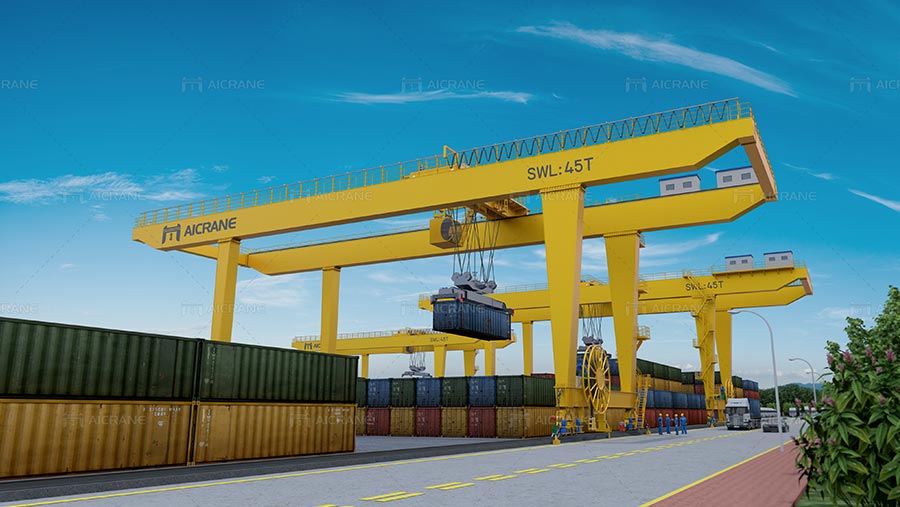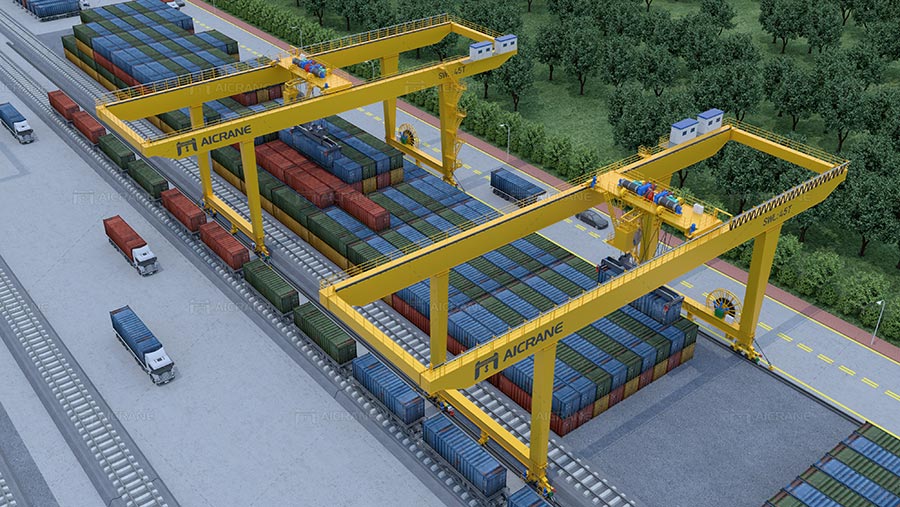Estimating the total cost of a rail mounted gantry crane (RMG crane) project requires a thorough understanding of various components involved in the acquisition, installation, operation, and maintenance of the crane. Whether you’re managing a port, container yard, or industrial facility, accurately estimating costs is crucial for budgeting and financial planning. This article outlines the key factors to consider when estimating the rail mounted gantry crane cost.

1. Initial Purchase Cost
The initial purchase cost of an RMG crane is a significant component of the total project cost. This cost varies depending on several factors:
- Crane Specifications: The capacity, span, and lifting height of the crane significantly impact the purchase price. Larger capacity and wider span cranes generally cost more due to increased material and design complexity.
- Technology and Features: Advanced technology, such as automated systems, remote controls, and integrated safety features, can increase the initial cost. Decide which features are necessary for your operations and balance cost versus benefits.
- Supplier and Brand: Different manufacturers offer various pricing structures based on their reputation, quality of materials, and technological advancements. Obtaining quotes from multiple suppliers can help in comparing costs of gantry cranes and finding the best deal.
2. Transportation and Delivery Costs
Transportation and delivery costs include the expenses associated with moving the crane from the manufacturer to the installation site:
- Shipping: The cost of shipping can vary based on the distance between the manufacturing facility and the installation site. It includes transportation by road, rail, or sea, depending on the location.
- Handling: Specialized handling may be required during transportation, particularly for large or heavy components. This includes loading, unloading, and securing the crane for transport.
- Insurance: Insurance for the crane during transit protects against potential damage or loss. The cost of insurance should be factored into the overall project budget.

3. Site Preparation Costs
Preparing the installation site is crucial for ensuring the crane operates efficiently and safely:
- Foundation Work: An RMG crane requires a robust foundation to support its weight and operational stresses. Costs include excavation, concrete work, and reinforcement.
- Rail Installation: The RMG container gantry crane runs on rails, which must be precisely aligned and installed. Rail installation involves costs for materials, labor, and alignment services.
- Utility Adjustments: If the installation site requires modifications to utilities such as power or water supply, these costs must be included in the site preparation budget.
4. Installation Costs
The installation process of an RMG crane involves several stages, each with associated costs:
- Crane Assembly: The crane must be assembled and erected on-site, which requires skilled labor and equipment. Installation costs vary based on the complexity of the crane and the site conditions.
- Electrical and Mechanical Setup: Connecting the crane to power sources, integrating control systems, and ensuring proper mechanical adjustments are essential for operational readiness. This includes costs for wiring, control systems, and calibration.
- Testing and Commissioning: Before the crane can be put into operation, it must undergo rigorous testing to ensure it meets safety and performance standards. This includes load testing and system checks.
5. Operational Costs
Operational costs are ongoing expenses associated with running the Aicrane gantry crane:
- Energy Consumption: RMG cranes consume electricity during operation. Energy costs vary based on crane usage, load handling, and energy efficiency.
- Labor Costs: Operating an RMG crane requires skilled personnel, including crane operators and maintenance staff. Labor costs include salaries, training, and any additional personnel required.
- Maintenance: Regular maintenance is essential to ensure the crane operates efficiently and safely. Maintenance costs include routine inspections, repairs, and parts replacement.
6. Maintenance and Repair Costs
Maintaining the crane in good working condition is crucial for its longevity and performance:
- Scheduled Maintenance: Routine maintenance, such as lubrication, inspections, and part replacements, is necessary to prevent breakdowns and ensure smooth operation.
- Unscheduled Repairs: Unexpected breakdowns or malfunctions may require repairs, which can be costly. Having a maintenance plan and budget for repairs is essential.
- Spare Parts: Stocking spare parts for quick replacements can minimize downtime but adds to the maintenance budget.
7. Training and Support Costs
Proper training and support ensure that the crane is used safely and effectively:
- Operator Training: Training crane operators is essential for safe and efficient operation. Training costs include courses, materials, and time spent by operators.
- Technical Support: Access to technical support from the manufacturer or service provider can be valuable for troubleshooting and resolving issues. Support costs may include service contracts or pay-per-service fees.
8. Contingency and Miscellaneous Costs
It’s essential to include a contingency fund in your budget to cover unforeseen expenses:
- Contingency Fund: Allocate a percentage of the total budget as a contingency to address unexpected costs or changes in project scope.
- Miscellaneous Costs: Consider other potential costs such as administrative fees, permits, and regulatory compliance.
Conclusion
Estimating the total cost of a rail mounted gantry crane project involves considering various factors, including initial purchase costs, transportation, site preparation, installation, operational expenses, maintenance, training, and contingency costs. By thoroughly evaluating each component and obtaining detailed quotes, you can develop a comprehensive budget that ensures the successful implementation of your RMG crane project. Accurate cost estimation not only helps in financial planning but also contributes to the efficient and effective management of the crane throughout its operational life.